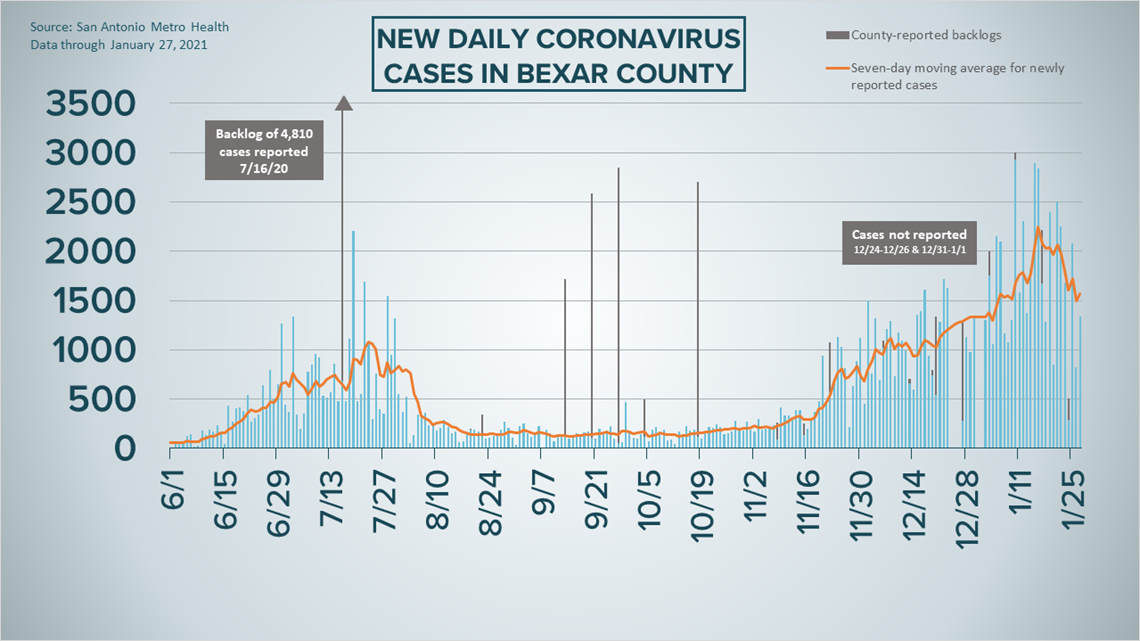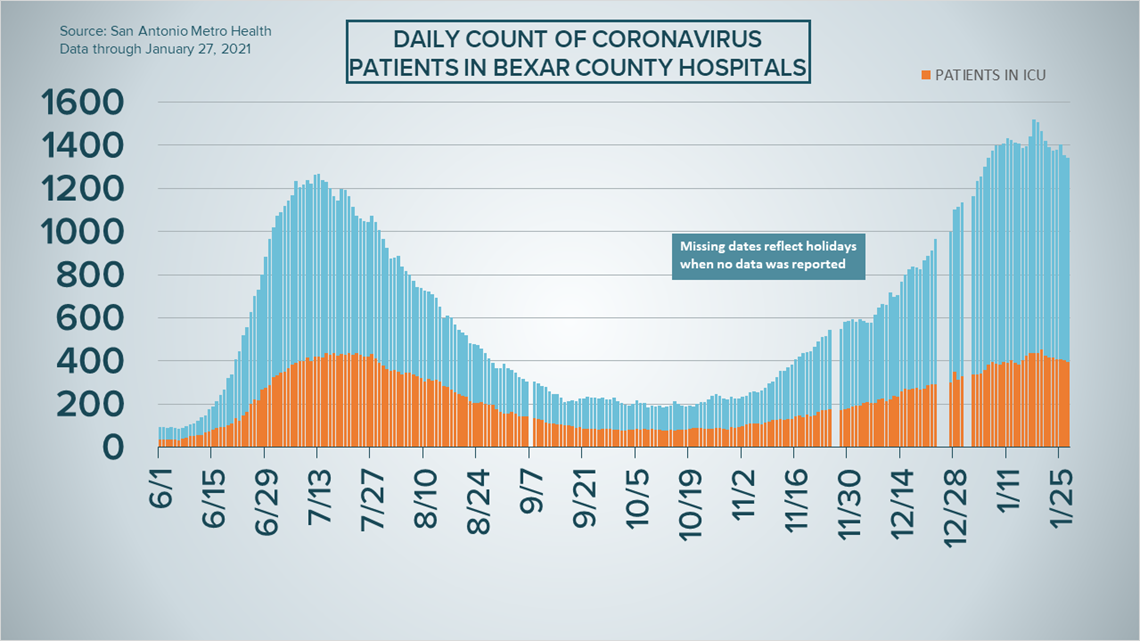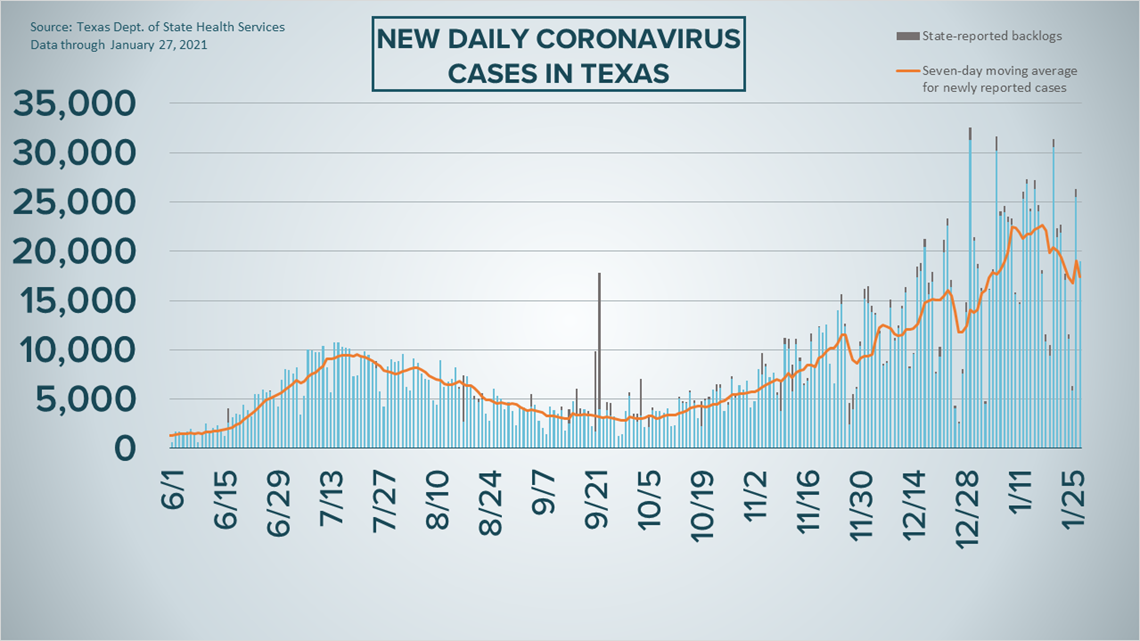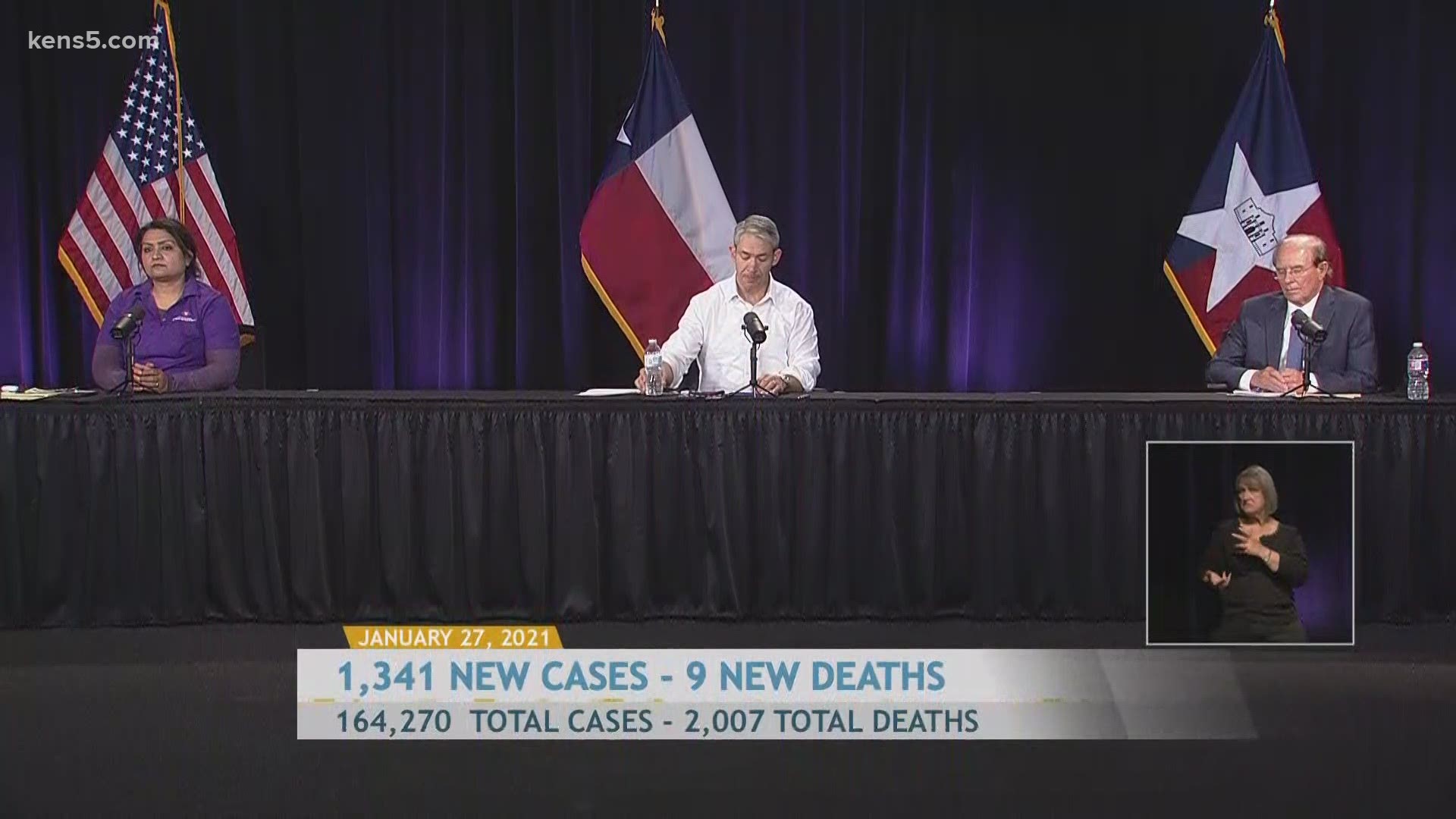SAN ANTONIO — We're tracking the latest numbers from the coronavirus pandemic in San Antonio and across Texas. Here are the latest numbers reported by Bexar and surrounding counties:
- Bexar County: On Wednesday, 1,341 new cases were reported, bringing the total number of cases to 164,270. Nine new deaths were also reported, raising the local death toll to 2,007.
- Hays County: On Wednesday, officials reported 79 new cases in the county and four additional COVID-related fatalities. As of Wednesday, there are a total of 14,719 lab-confirmed local cases, while the death toll rose to 181. Officials estimate 12,195 residents have recovered, while 2,343 are still ill with the virus.
- Comal County: On Thursday, officials reported 109 new cases and no additional COVID-related fatalities. There are a total of 7,999 cases, including 4,296 confirmed and 3,690 probable cases, while 242 county residents have died due to COVID-19 complications. The county estimates 7,039 residents have recovered, while 718 are still ill with the virus.
More county case information is available through the Texas Department of Health Services COVID-19 dashboard.
How Bexar County is trending
We've tracked how many coronavirus cases have been confirmed in Bexar County from the time officials began reporting cases in March 2020. The graphic below shows the number of cases since June and charts those daily case numbers along a 7-day moving average to provide a more accurate picture of the overall coronavirus case curve in our area and the direction we're trending amid the pandemic.
On Wednesday, Mayor Ron Nirenberg reported an additional 1,341 new coronavirus cases in Bexar County. In all, 164,270 Bexar County residents have been diagnosed with the virus, while the seven-day moving average rose to 1,567; just over a week ago, the seven-day moving average hit an all-time peak at 2,251.
Nirenberg also reported nine new coronavirus-related deaths, for a total of 2,007 in the county since the pandemic began. Wednesday's report ended a streak of eight consecutive days with double-digit fatalities reported.


Meanwhile, there were 12 fewer coronavirus hospitalizations on Wednesday compared to Tuesday, for a concurrent total of 1,341. That's the lowest number of hospitalized patients since January 6. 394 patients are in intensive care, the lowest that number's reached since January 13, while 255 patients are on ventilators. 164 new patients were admitted in the last 24 hours.
32.7% of hospitalized patients in Bexar County have COVID-19.


Coronavirus in Texas
The total number of novel coronavirus cases in the state since the pandemic began grew by 18,944 on Wednesday, according to the Texas Department of State Health Services. That total includes 14,731 new confirmed cases and 4,213 new probable cases. DSHS has yet to release details on any backlogged cases for Wednesday. (more details can be found at the top of this page).
Wednesday's figures bring the total number of Texans diagnosed with COVID-19 to more than 2.293 million. Texas crossed 2 million total confirmed cases on Wednesday.


Meanwhile, state health authorities reported another 467 deaths from coronavirus complications in Texas. In all, 35,168 Texans have died from COVID-19.
The number of COVID-19 patients receiving treatment for their symptoms decreased on Wednesday by 56. The concurrent total stands at 12,795.
Per their last update Tuesday, the state estimates that about 1.845 million Texans have recovered, while 376,862 Texans remain ill with COVID-19.
The latest update from the Texas Education Agency showed that there have been at least 128,973 cumulative cases among staff and students across the state through January 17. That number comprises 81,118 positive student cases and 47,885 staff cases. More information can be found here.
The TEA releases new data on school cases on Fridays.
Latest Coronavirus Headlines
- NISD asks parents to keep kids home for virtual learning for at least one more week
- Walmart will offer COVID-19 vaccinations near Beaumont, a few other Texas cities
- Health officials hold first White House COVID-19 briefing under President Biden
- Shoah survivors to get COVID-19 vaccine on Auschwitz liberation day
- Walmart to build more robot-filled warehouses at stores
- 'We had to change our hat and turn': Texas business owners credit COVID-19 pandemic changes for unprecedented success
- US boosting vaccine deliveries amid complaints of shortages
- IOC, Tokyo Olympics to unveil rule book for beating pandemic
- $2,400 stimulus check for moms? Charlize Theron, Amy Schumer among celebrities making case to Biden
Coronavirus symptoms
The symptoms of coronavirus can be similar to the flu or a bad cold. Symptoms include fever or chills, cough, shortness of breath or difficulty breathing, fatigue, muscle or body aches, headache, new loss of taste or smell sore throat, congestion or runny nose, nausea or vomiting, and diarrhea, according to the Centers for Disease Control.
Most healthy people will have mild symptoms. A study of more than 72,000 patients by the Centers for Disease Control in China showed 80 percent of the cases there were mild.
But infections can cause pneumonia, severe acute respiratory syndrome, kidney failure, and even death, according to the World Health Organization. Older people with underlying health conditions are most at risk.
Experts determined there was consistent evidence these conditions increase a person's risk, regardless of age:
- Chronic kidney disease
- COPD (chronic obstructive pulmonary disease)
- Obesity (BMI of 30 or higher)
- Immunocompromised state (weakened immune system) from solid organ transplant
- Serious heart conditions, such as heart failure, coronary artery disease, or cardiomyopathies
- Sickle cell disease
- Type 2 diabetes
The CDC believes symptoms may appear anywhere from two to 14 days after being exposed.
Human coronaviruses are usually spread...
- Between people who are in close contact with one another (within about 6 feet).
- Through respiratory droplets produced when an infected person coughs, sneezes or talks. These droplets can land in the mouths or noses of people who are nearby or possibly be inhaled into the lungs.
- Some recent studies have suggested that COVID-19 may be spread by people who are not showing symptoms.
Help stop the spread of coronavirus
- Stay home when you are sick.
- Eat and sleep separately from your family members
- Use different utensils and dishes
- Cover your cough or sneeze with your arm, not your hand.
- If you use a tissue, throw it in the trash.
Find a Testing Location
City officials recommend getting a COVID-19 test if you experience fever or chills, cough, shortness of breath or difficulty breathing, fatigue, muscle or body aches, headache, new loss of taste or smell, sore throat, congestion or runny nose, nausea or vomiting, or diarrhea.
San Antonio operates several no-cost testing locations, including two walk-up locations open Monday-Sunday from 10 a.m. until 2 p.m.:
Cuellar Community Center
5626 San Fernando St.
San Antonio, TX 78237
Ramirez Community Center
1011 Gillette Blvd.
San Antonio, TX 78224
Additionally, Freeman Coliseum offers drive-through no-cost testing from Monday through Sunday between 9 a.m. and 4 p.m. An appointment is required and can be made either online or by calling (833) 213-0643.
Here's a Testing Sites Locator to help you find the testing location closest to you in San Antonio.

